Amelia Aerhart’s Electra Found?
Amelia Aerhart was a truly extraordinary woman and a fearless adventurer and pioneer. Unfortunately this icon disappeared over the Pacific Ocean while almost completing her journey around the world in 1937.
Due to the amazing research by the TIGHAR organization in piecing many elements of evidence from radar positioning to complex decades old analysis. It is highly rationalized and hypothesized that Aerhart landed on Nikumaroro Island in 1937 in possibly a last ditch effort at survival by crash landing her Lockheed Electra at low tide on the North West end of the Island.
Fascinated with this mystery, we looked into this ourselves and found this (imaged below), which we believe validates that indeed there was a plane that disturbed the surface layer of this area. The Electra had wingspan of about 16m, which matches the feature below:
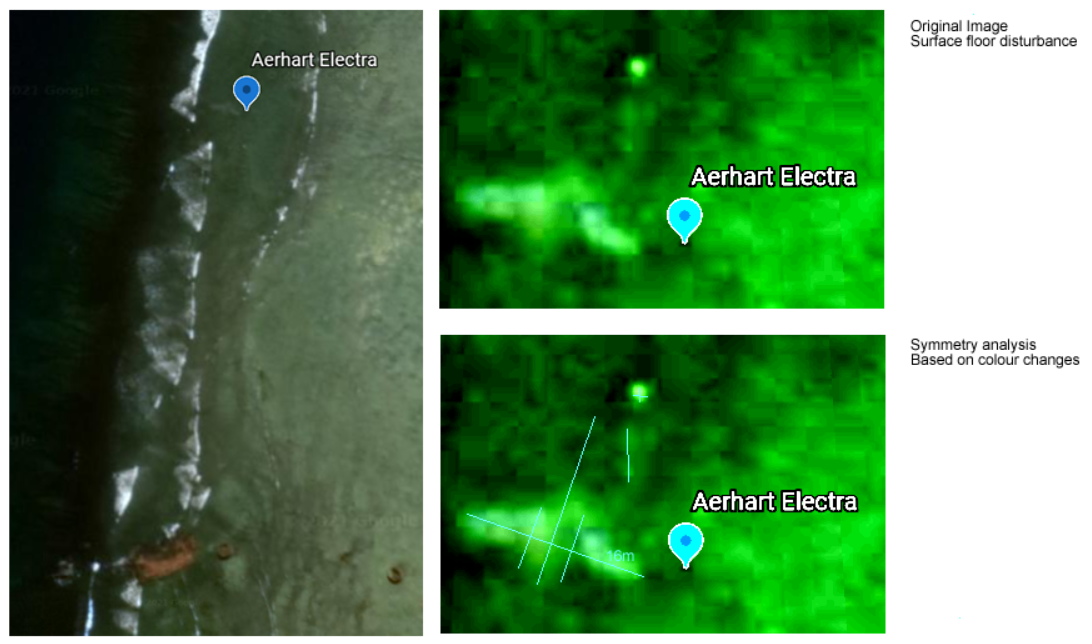

References
Dragons Were Dinosaurs That Existed With Humans
Throughout historic legends, there was stories of the dragons, such as Jormungandr for Norse mythology and the Leviathan from the Bible, that clearly depict humans coexisting with animals that very much resemble dinosaurs. In the case of Jormungandr and the Leviathan, the seemingly disparate legends appear to describe the same legendary sea animal that resembles an aquatic dinosaur, according to the very interesting book “Norse Mythology Rooted in Ancient Mesopotamia”. The word dinosaur didn’t exist until the 1800s. Before that time, dinosaur bones were still being found, but that most etymological common name for such animals was associated with legendary stories of dragons. The word “dragon” is assumed to have been a catch all name for all animals found alive or dead (ex. fossilized) that resembled dinosaurs. But this leads to the obvious, did ancient humans go-exist with “dragons” as the legends state in order for them to associate physical characteristics currently attributed to dinosaurs to dragons? I personally suspect that some dinosaurs did indeed survive mass extinctions and co-existed with humans in the ancient past before they too went extinct.
There is evidence that some exist today in remote locations, like in central African in the middle of its massive jungles as some recent eye-witness reports suggest (documented by the History Channel and televised).

(image owner: https://en.wikipedia.org/wiki/Dragon#/media/File:Martorell_-_Sant_Jordi.jpg)
The following video by “Restoring Genesis Film” documents well the subject of dragons.
Ancient Tolima Quimbaya Airplanes?
Some years ago in Columbia, many small ancient gold artifacts believed to be related to the Quimbaya Civilization of 1000 C.E. were found. Of the hundreds of gold artifacts depicting what appears to be various animals, there were about 12 artifacts that looked surprisingly like modern day aircraft.
Some skeptics argue that these plane-like figurines are actually depicting certain types of fish, which are obviously naturally hydrodynamic. This is a plausible possibility, but what is striking about these figurines are the large vertical tails that are triangular on the top side and have no reciprocating symmetry on the bottom like the tails of most fish. A plane with a proportionally large vertical tail would inherently have exceptional stability, especially when considering the other aerodynamic aspects of the figurines. Additionally, the these figurines are horizontal tail wings with a symmetry very similar to modern planes. And then there are the proportionally large delta wings that don’t fit any known fish.

(Artifact image owner: Museo Del Oro, Bogota, Columbia)
In 1994, Germans Peter Belting and Conrad Lubbers created large scaled working remote radio controlled versions of two of these figurines, each with a different propulsion design, and they flew remarkably well. If these figurines were depicting fish, the fish’s hydro-dynamical features could allow for flight with enough propulsive force.
Here is a free video from Mr. Herbert Science Class in which he also created working scaled remote controlled airplanes, including the holes in the wing (goto 5:35 min).
References
“Quimbaya Artifacts“, https://en.wikipedia.org/wiki/Quimbaya_artifacts, Retrieved April 2015
“Quimbaya Civilization“, https://en.wikipedia.org/wiki/Quimbaya_civilization , Retrieved April 2015
Museum of Gold, Bogota, Columbia http://www.banrepcultural.org/museo-del-oro
“The Revolutionary Quimbaya Airplanes“, http://ancientufo.org/2015/11/the-revolutionary-quimbaya-airplanes/ , Retrieved April 2015
“Quimbaya (Tolima) Airplanes“, http://www.theancientaliens.com/#!technology–quimbaya-airplanes/ciu4 , Retrieved April 2015
Gobekli Tepe (12,000 Years Old)
Initially discovered by a Turkish shepherd, and claimed by to have been spotted in a survey conducted by the University of Istanbul and University of Chicago in 1963, the archeological site of Gobekli Tepe is anomalous because it contradicts much of mainstream history about how old human civilization and levels of certain technological knowledge really are. The site has been conservatively dated to 10,000 BC (12,000 years old), which is older than our earliest believed civilizations, like that of Sumer and Egypt, by at least 6,000 years. It was already ancient to ancient Sumer.
The very ancient structures at Gobekli Tepe are astonishing. The sophistication of site and masonry work far exceeds what history and archeological scholars believed possible for 10,000 BC. The site features many circular “rooms” with carved stone pillars that appears to be been used to hold up a roof. On the pillars and other artifacts are carved animal reliefs that would have required immense skill to accomplish. Even though there are theories, the exact purpose of the site is unknown.
The site appears to have been buried for some unknown reason around 8,000 BC, 2,000 years after it’s construction. The site seems well preserved with little sign of destruction, except for the fact it was just buried. There is reasonable speculation that perhaps the site was buried by an ancient flood, perhaps the Biblical Great Flood, which may make sense if the flood brought with it enough lifted ground sediment (dirt and mud) to bury the site naturally without the violent waters of a tsunami.
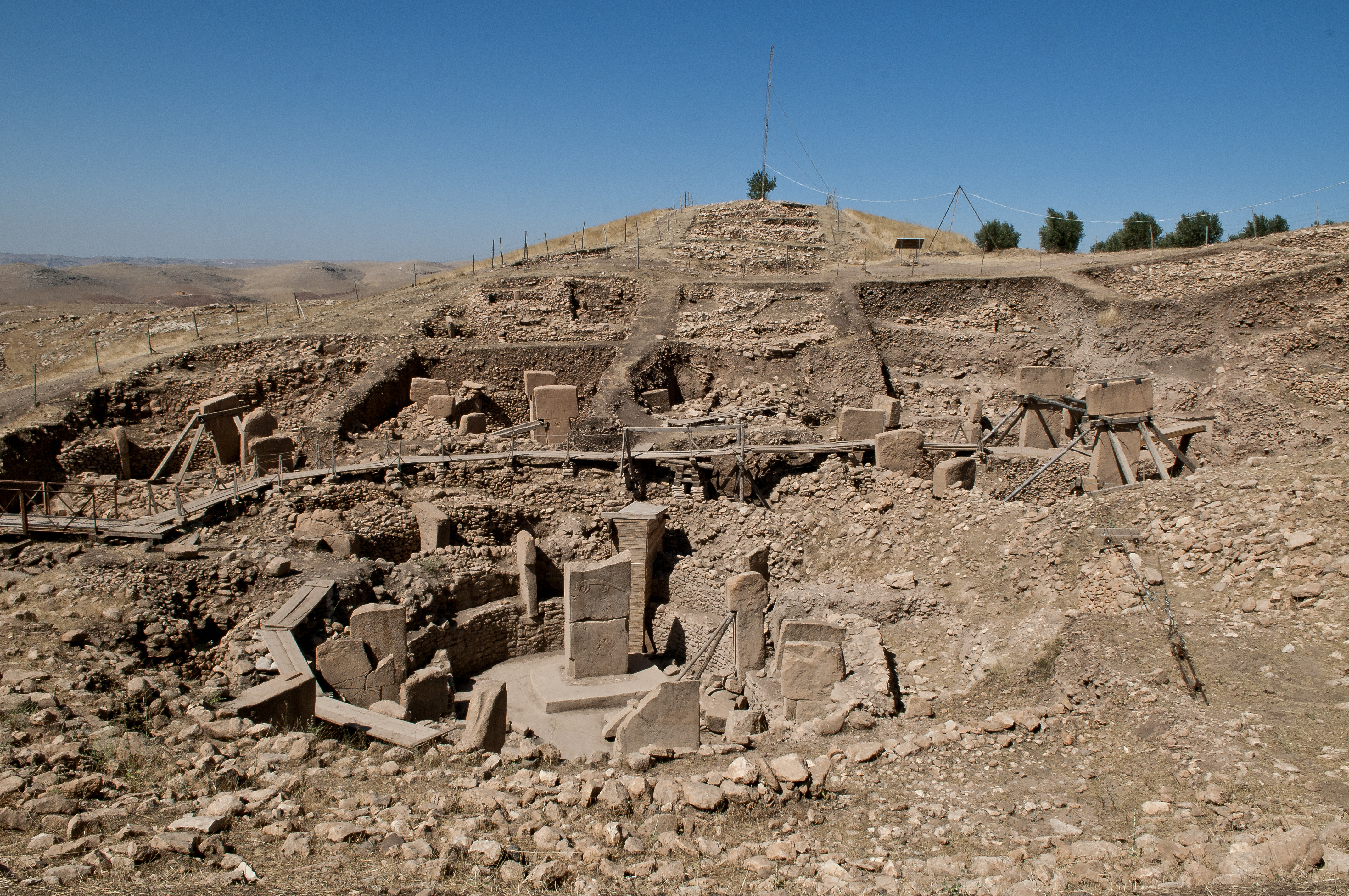
(image owner: https://en.wikipedia.org/wiki/File:G%C3%B6bekli_Tepe,_Urfa.jpg)
(Image owner: https://commons.wikimedia.org/wiki/File:G%C3%B6bekli_Tepe_site_(1).JPG)
References:
Real Ancient North American History
The pre-European history of America and Canada has a lot of anomalous evidence in contrast to the history that’s been taught in the history books throughout the centuries. The subject is soo large that all this specific MainframeX.com record is indented to do is start the documentation of these disparities between the anomalous evidence and what has been taught in the history books since Europeans arrived and colonized the land.
There are prevailing preconceived notions that the indigenous peoples of America and Canada were primitive, uncivilized, nomadic, had no written language and didn’t have any of the advanced knowledge and technologies the Europeans had. Evidence has been turning up since the beginning of European arrival that has been in stark contradiction to all these notions and assumed facts.
What the majority of history books (taught in schools) have failed to mentioned is that indigenous peoples of the Americas had:
1) over 200,000 well organized and advanced structured cities and mounds throughout the continent (ex. mount builders of Missouri, city of Monks Mound in Cahokia, and many more)
2) well established trade routes, some of which were very long
3) knowledge and technology to smelt metal and fashion metal objects (ex. numerous pre-Columbian metal objects have been found, Mississippian culture copper artifacts)
4) written language
5) numerous giant earthworks throughout the continent that would require immense organization of workers and architectural skills
In addition to this, there are numerous mysterious large dolmens located throughout the Americas and structures that some have suggested are megalithic that would require advanced technologies to erect and lift enormous stones.
Also, diffusionists believe there is compelling evidence suggesting that some of indigenous peoples of America were descendants of ancient Semitic people, with some evidence suggesting a link to the Phoenicians, who are themselves linked to the ancient Assyrian Empire. This evidence consists of numerous objects found with an ancient version of Hebrew written on them, and the fact the many indigenous people have DNA from haplogroup X, where the other primary source of this haplotype originates in the Middle East.
Again this barely scratches the surface of all the evidence that exists.
There is also evidence suggesting in the 1900s that political, bias and racist beliefs drove very early archeological sciences in the Americas to skew and suppress the actual history of indigenous people.

(An artist’s rendition of Cahokia Mounds in 1150 AD. Photo credit: Cahokia Mounds Museum Society and Art Grossman)
(Monks Mound in Cahokia. Image owner: https://commons.wikimedia.org/wiki/File:Monks_Mound_in_July.JPG)
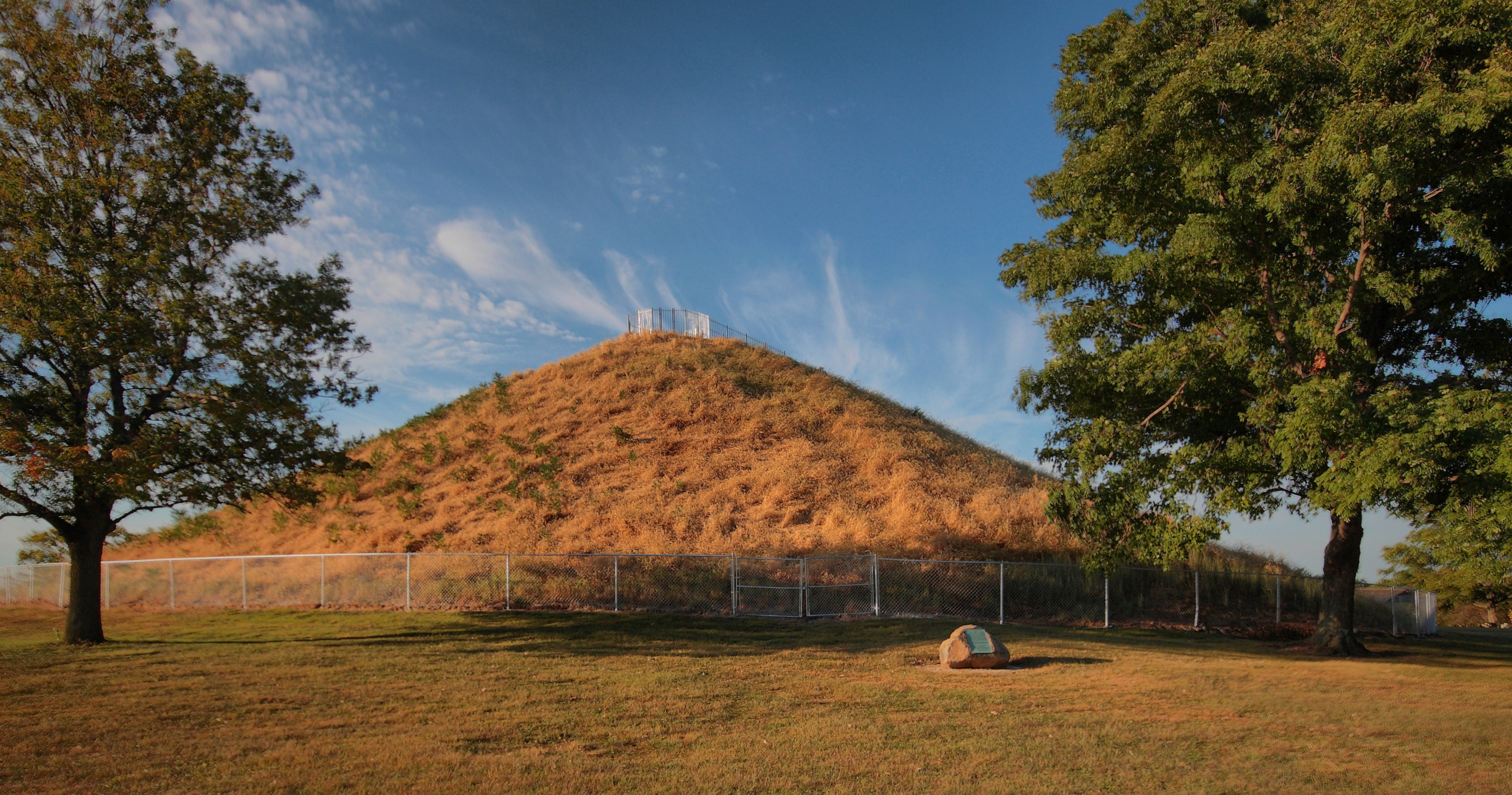
(Miamisburg Mound in Miamisburg, Ohio. Image owner: https://commons.wikimedia.org/wiki/File:MoundElevation.jpg)
The following video found on YouTube goes into excellent detail of the disparities and anomalous evidence that exists of ancient pre-Columbian American history.
(The Lost Civilizations of North America Documentary Trailer: http://www.lostcivilizationdvd.com/documentary.html)
Reference:
https://en.wikipedia.org/wiki/Cahokia
https://www.ohiohistory.org/visit/museum-and-site-locator/miamisburg-mound
http://www.lostcivilizationdvd.com/
The Mysterious Richat Structure (Atlantis?)
Initially this structure in Mauritania was thought to be an impact structure. It is now believed to be an eroded salt dome, but how it was formed is inconclusive. It is 50 km in diameter (23.5 km largest inner ring), about the size of modern city.
Besides this structure’s mysterious geological origins, it has been proposed by some that this structure closely resembles Plato’s ancient description of Altantis with its large concentric circular rings, and it really does match Plato’s description of Atlantis. It is also located in a region in Mauritania south west of the Pillars of Hercules (Strait of Gibraltar) below the Atlas Mountain range (“Atlantis” mountain range?).
It has been proposed by some researchers that Atlantis existed in the Antediluvian era, in a time before the Great Flood and the prehistoric ancient world’s destruction, and that it was destroyed by the Great Flood in a giant tsunami. It is also possible that parts of the ancient Sahara Desert were ocean. The structure itself does contain salt implying a dried up ancient sea. Perhaps the Mediterranean Sea spilled into the Sahara Desert during or prior to the last ice age, and that water subsequently spilled into the Atlantic ocean. Or it’s possible the land elevations in the past were very different than they are today. There also appears to be on main “channel” or “canal” leading away from the structure, which matches Plato’s description also.
One research has suggested that if this isn’t Atlantis itself, that it is perhaps an ancient city belonging to Poseidon’s ancient empire collectively called Atlantis, which later changed phonologically to “Atlantic”, where Poseidon was a king, not a god.
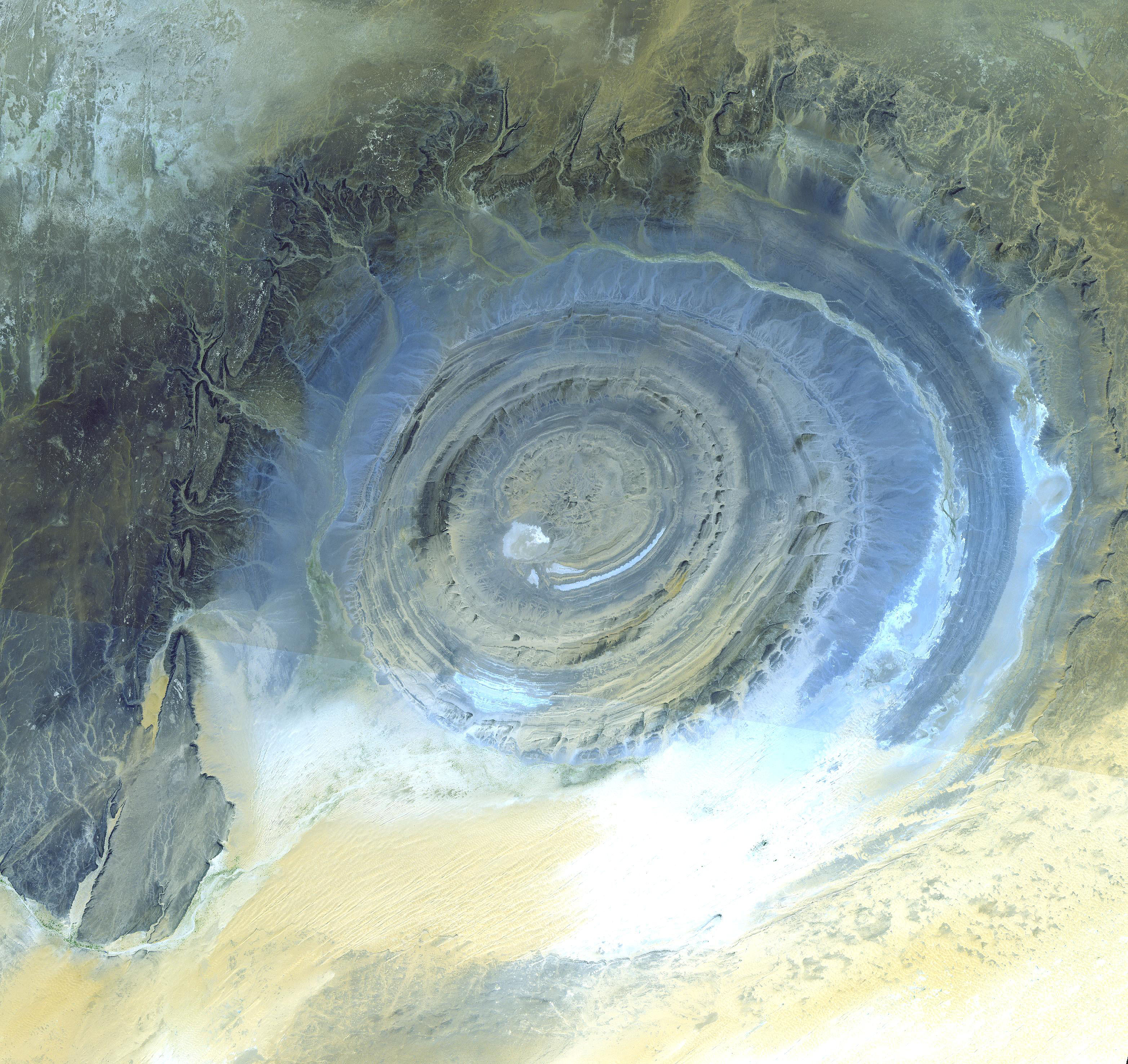
(Image owner: https://commons.wikimedia.org/wiki/File:ASTER_Richat.jpg)
The following is the only free movie linking the Richat Structure to Atlantis:
References
http://www.gpofr.com/documents/2012Atlantis.pdf (broken link 2014)
Captured: 2012-Atlantis.pdf
https://en.wikipedia.org/wiki/Richat_Structure
Anomalous Underwater Pattern in the Atlantic (Atlantis?)
There was an anomalous underwater pattern in the Atlantic discovered on Google Earth by various sources that was about 50 km x 50 km. The images are reportedly collected by government resources and given to Google for their Google Earth and Google Maps products. The grid pattern of this image looks like a very large, somewhat symmetrical, city. Some have linked this to a possible site for Atlantis since it’s located in the Atlantic and outside the Pillars of Hercules (Strait of Gibraltar).
Skeptics believe that this anomalous pattern is nothing more than ship tracks, but aspects of the lines in the pattern do not meet the criteria for ship tracks.
Ultimately what this anomaly really is is unknown.
The FarSight video here goes into the hypothetical of what this pattern might actually be. Given the lack of underwater exploration of this sight, this is perhaps the best anyone can surmise if indeed these lines are not ship tracks.
References
http://www.gpofr.com/documents/2012Atlantis.pdf (broken link 2014)
Mars Crab – Complex and Symmetrical
A picture taken by the Mars Curiosity Rover on the red planet shows a crab-like creature climbing a rock wall. The anomalous aspect of this image is that the crab-like creature is symmetrical.
The symmetry of the crab-like creature is virtually undeniable. To further compound the symmetrical coincidence is that the symmetry is complex, having 6 legs lined up as the following image demonstrates.

References
Saqqara Bird (Ancient Model Plane?)
The Saqqara Bird is a bird shaped artifact made of sycamore wood, discovered during the 1898 excavation of the Pa-di-Imen tomb in Saqqara, Egypt. It is dates to about 200 BC. It’s current home is in the Museum of Egyptian Antiquities in Cairo.
The Saqqara Bird has a wingspan of 180 mm (7.1 in) and weighs 39.12 g (1.380 oz). Its function is not understood because of a lack of period documentation.
The anomalous problem is that the structure of the wooden bird has elements very similar to modern aircraft. It is very aerodynamic, the wings have curvatures allowing lift dynamic, and the tail in particular is vertical, and definitely not similar to bird’s tail. The tail resembles the tail rudder of modern airplanes. Also there is evidence that the tail is missing a horizontal piece, making it even more similar to modern planes.
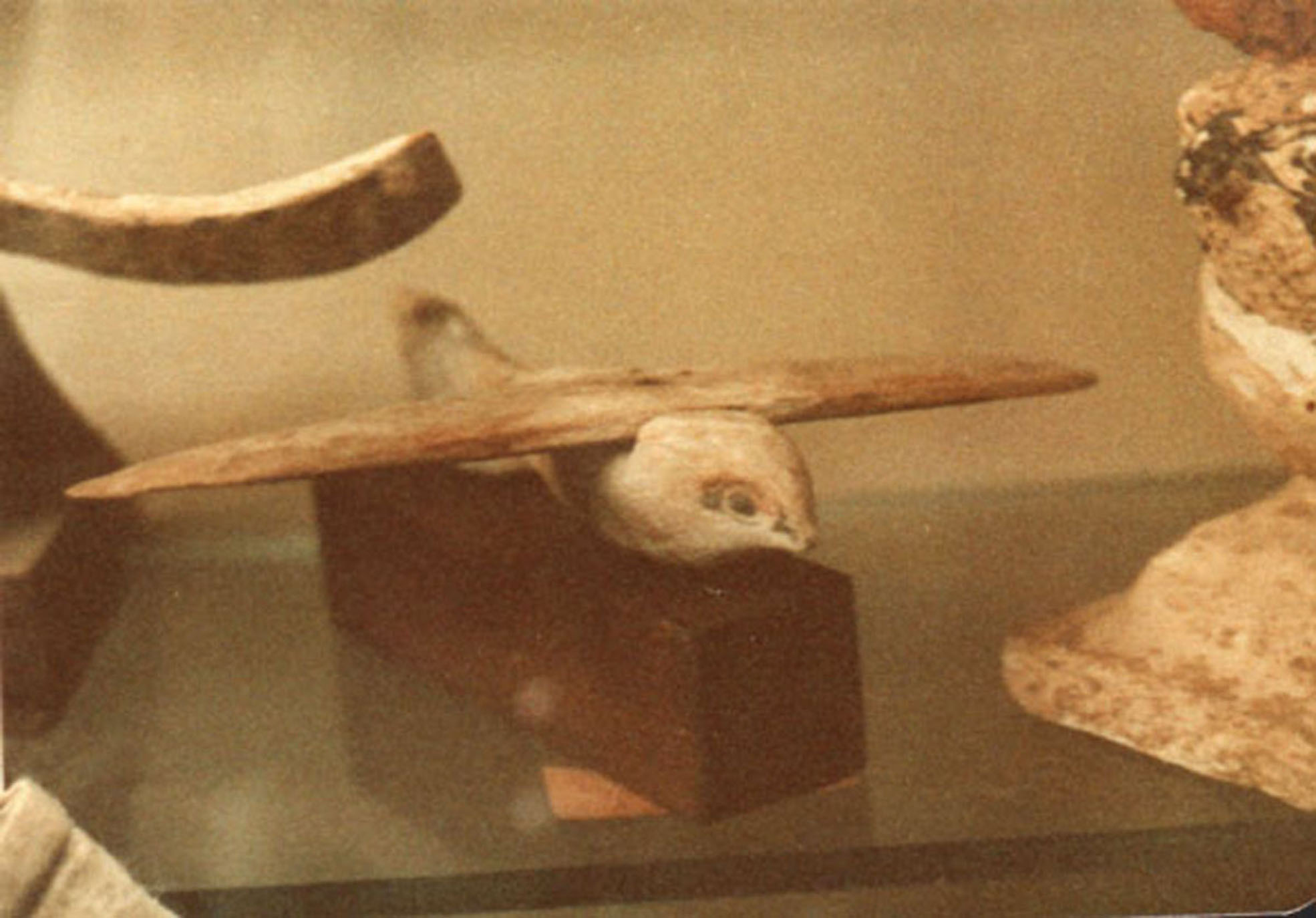
(Image ownership: https://commons.wikimedia.org/wiki/File:Photo_1-plane_front_view1.jpg)
References
